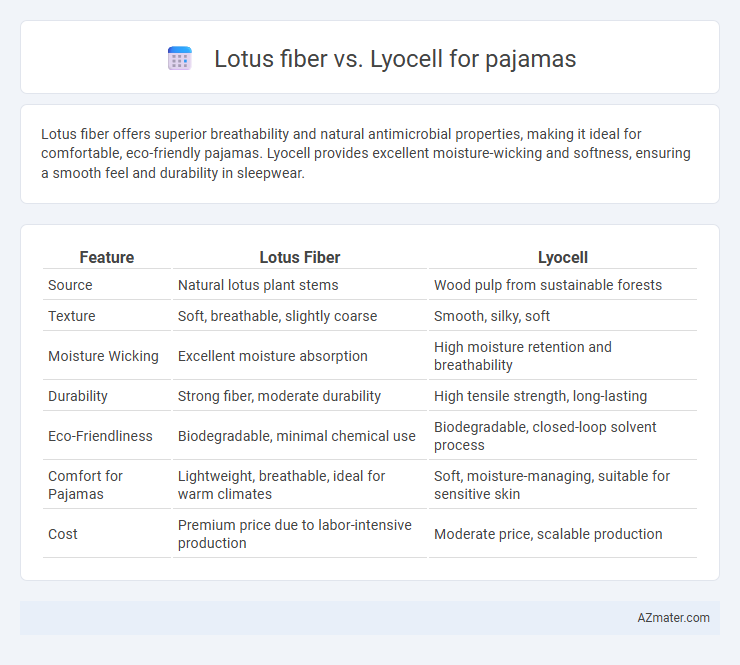Lotus fiber offers superior breathability and natural antimicrobial properties, making it ideal for comfortable, eco-friendly pajamas. Lyocell provides excellent moisture-wicking and softness, ensuring a smooth feel and durability in sleepwear.
Table of Comparison
| Feature | Lotus Fiber | Lyocell |
|---|---|---|
| Source | Natural lotus plant stems | Wood pulp from sustainable forests |
| Texture | Soft, breathable, slightly coarse | Smooth, silky, soft |
| Moisture Wicking | Excellent moisture absorption | High moisture retention and breathability |
| Durability | Strong fiber, moderate durability | High tensile strength, long-lasting |
| Eco-Friendliness | Biodegradable, minimal chemical use | Biodegradable, closed-loop solvent process |
| Comfort for Pajamas | Lightweight, breathable, ideal for warm climates | Soft, moisture-managing, suitable for sensitive skin |
| Cost | Premium price due to labor-intensive production | Moderate price, scalable production |
Introduction to Lotus Fiber and Lyocell
Lotus fiber, derived from the lotus plant's stem, is renowned for its natural breathability, softness, and eco-friendly cultivation, making it ideal for sustainable pajama fabrics. Lyocell, a semi-synthetic fiber produced from sustainably sourced wood pulp through a closed-loop process, offers exceptional moisture-wicking properties, durability, and a silky smooth texture suitable for comfortable sleepwear. Both fibers prioritize sustainability and comfort, but lotus fiber provides a unique natural origin, while lyocell excels in consistency and fabric performance.
Origins and Production Methods
Lotus fiber, derived from the stems of the lotus plant native to Southeast Asia, is harvested through a labor-intensive process where fibers are manually extracted, dried, and spun into yarn. Lyocell is a semi-synthetic fiber produced from sustainably sourced wood pulp, primarily eucalyptus, using a closed-loop solvent spinning method that minimizes environmental impact. The natural, biodegradable lotus fiber contrasts with lyocell's eco-friendly industrial production, influencing texture, durability, and sustainability profiles in pajama fabrics.
Environmental Impact Comparison
Lotus fiber and Lyocell both offer environmentally friendly options for pajamas with distinct benefits. Lotus fiber is biodegradable and derived from sustainable lotus plant stems, requiring minimal water and no harmful chemicals during extraction. Lyocell is produced from sustainably sourced eucalyptus wood pulp using a closed-loop process that recycles solvents and minimizes waste and water usage, making it a low-impact fabric with a higher energy footprint compared to lotus fiber.
Texture and Comfort Differences
Lotus fiber offers a naturally textured, slightly coarse feel that softens with washing, providing breathable comfort and excellent moisture absorption for pajamas. Lyocell features a smooth, silky texture with superior softness and drape, enhancing comfort with its hypoallergenic and moisture-wicking properties. Both fibers excel in breathability, but lotus fiber delivers a more organic, textured experience while lyocell prioritizes luxurious softness.
Breathability and Moisture-Wicking Abilities
Lotus fiber offers exceptional breathability and natural moisture-wicking properties, making it ideal for pajamas in hot and humid climates. Lyocell, derived from sustainably sourced wood pulp, is highly breathable and excels at moisture management due to its smooth fiber structure that quickly absorbs and releases moisture. Both fibers provide superior comfort, but lotus fiber stands out for its hypoallergenic qualities and natural antibacterial benefits.
Durability and Longevity
Lotus fiber exhibits exceptional durability due to its natural strength and resistance to wear, making it an ideal choice for long-lasting pajamas. Lyocell, derived from wood pulp through a closed-loop process, offers softness and breathability but tends to be less resistant to abrasion compared to lotus fiber. When prioritizing longevity in pajama fabrics, lotus fiber maintains integrity and texture over extended use more effectively than lyocell.
Hypoallergenic and Skin-Friendly Properties
Lotus fiber exhibits superior hypoallergenic qualities due to its natural resistance to bacteria and allergens, making it ideal for sensitive skin in pajamas. Lyocell, derived from sustainable wood pulp, is also skin-friendly with moisture-wicking and breathability properties that reduce irritation. Both fibers enhance comfort, but lotus fiber's inherent antimicrobial traits offer an edge for those seeking optimal skin health.
Aesthetic Appeal and Fabric Finish
Lotus fiber offers a unique, natural sheen and a slightly textured finish that enhances the rustic and organic aesthetic appeal of pajamas, creating a subtle elegance. Lyocell, known for its smooth and silky surface, provides a lustrous, polished finish that elevates pajamas with a modern, soft drape and vibrant color retention. The choice between lotus fiber and lyocell significantly influences the visual and tactile sophistication of pajama fabrics.
Price and Market Availability
Lotus fiber pajamas typically come with a higher price point due to the labor-intensive extraction process and limited cultivation of lotus plants, resulting in niche market availability primarily in luxury and eco-conscious segments. Lyocell pajamas, produced through a more scalable and cost-effective manufacturing process using sustainably sourced wood pulp, offer competitive pricing and widespread market availability across mainstream and sustainable clothing retailers. Consumers seeking affordable, environmentally friendly sleepwear generally find Lyocell options more accessible than the premium-priced, artisanal lotus fiber alternatives.
Verdict: Choosing the Right Fabric for Pajamas
Lotus fiber offers exceptional breathability and natural antibacterial properties, making it ideal for lightweight, summer pajamas, while lyocell provides superior softness, moisture-wicking, and durability for year-round comfort. Both fabrics are sustainable, but lyocell's easy care and wrinkle resistance cater well to everyday use. Choosing between them depends on preferences for texture and climate, with lotus fiber favored for hot weather and lyocell preferred for versatile, all-season pajamas.

Infographic: Lotus fiber vs Lyocell for Pajama
 azmater.com
azmater.com